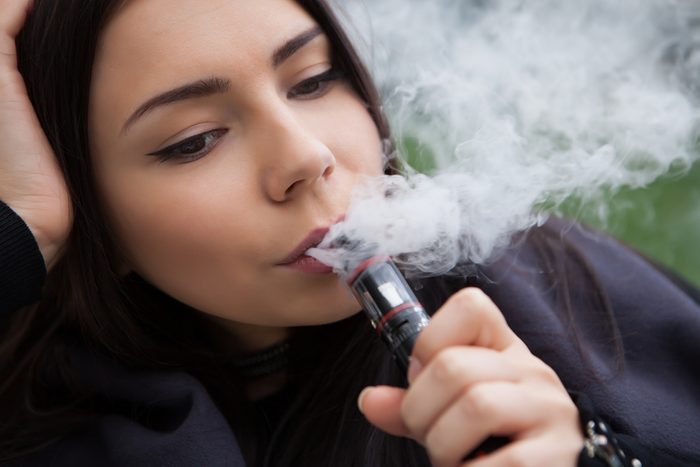
What is vaping?
The latest public health crisis. That’s how medical experts are referring to the health problems resulting from vaping. Hundreds of people have become seriously ill after using the electronic devices. Some people have died. The Federal Drug Administration (FDA) and Drug Enforcement Administration (DEA) have opened a criminal investigation into the illnesses. Here’s what you need to know to protect yourself.
Vaping is the inhalation of an aerosol from an electronic cigarette or similar device, which is used to heat the vapor-producing liquid. The most well-known and popular brand of electronic cigarette is the JUUL but there are many more types and they come in a variety of shapes and sizes. Many are pen-like (hence the term vape pen) or they may also resemble a USB flash drive. The vapor usually delivers nicotine but it can also deliver other legal or illegal substances, including tetrahydrocannabinol (THC), the active ingredient in marijuana. In addition, the liquid can contain fine particles, oils, toxic chemicals, or other ingredients, some that have been linked to cancer, lung problems, and possibly heart disease.

How common is vaping?
E-cigarettes were introduced in 2007 and have increased in popularity since then, especially among young people. The National Institutes of Health reported that vaping among high school seniors doubled from 11 percent in 2017 to 21 percent in 2018. But many adults also vape: A 2018 study in the Annals of Internal Medicine found that 11 million U.S. adults in 2016 used e-cigarettes. The Centers for Disease Control and Prevention (CDC) is urging consumers to refrain from using vaping products for the following reasons.

You can get very sick
More than 1,000 cases of vaping-related lung injuries, from 48 states and one U.S. territory, have been reported to the CDC. The symptoms of the lung disease resulting from vaping include coughing, shortness of breath, chest pain, nausea, vomiting, diarrhea, fatigue, and stomach pain. Nearly 70 percent of cases are in males. Nearly two thirds (62 percent) of people who have gotten sick are between the ages of 18 and 34, and 16% are under 18. Some of the people used vaping devices that delivered nicotine, but most have used THC-containing products.

You can die
As of the publication of this article, there have been 18 confirmed deaths linked to vaping. The cause, said Robert Goldberg, MD, pulmonologist at Mission Community Hospital in Mission Viejo, California, was acute respiratory distress syndrome (ARDS). The first death was reported on August 23 in Illinois. Although many cases were seen in younger people using e-cigarettes, they can happen in people of any age—one person who died was 71.

Vaping can be addictive
“Nicotine is an extremely addictive chemical,” says Dr. Goldberg. And although it can vary, vaping may provide more nicotine per inhalation than traditional cigarettes. “The amount in one puff from a vaping device is greater than in one puff from a cigarette.” Many of the vaping companies used fun names and created fruity flavors like Fruity Freeze and So Berry Good to appeal to children and make them dependent on the devices. Often young users were unaware that the devices even delivered nicotine. “Companies saw a gold mine,” Dr. Goldberg says. “If they could hook a new population on nicotine, they would have customers for life.”

Vaping isn’t regulated
Vape devices and liquids aren’t regulated by the FDA, so it’s not known what other chemicals are being used to deliver the nicotine. “When you vape, you are bringing unknown chemicals into your body that aren’t being regulated,” Dr. Goldberg says. The devices and e-liquids (or vape juice) are also sold on the black market, and those are even less reputable, he said. “We don’t know what’s in the devices.”
“Anyone who uses e-cigarette, or vaping, products should not buy these products (e.g., e-cigarette or vaping products with THC or CBD oils) from informal sources (e.g. friends, family members) or “off the street,” and should not modify or add any substances to these products that are not intended by the manufacturer,” the CDC says.

Vaping may increase your risk of lung disease
Even before recent reports of the serious and deadly lung diseases, vaping was known to have a negative effect on the respiratory system. “Early on, I would see patients who were vaping have an asthma-like syndrome—they were coughing and wheezing,” Dr. Goldberg says. “We were seeing patients developing lung disease from vaping.” Some flavored varieties of vape juice also contain diacetyl, a chemical known to cause a rare and serious lung condition called bronchiolitis obliterans. The condition is called “popcorn lung” because it has been known to occur in people who inhaled the chemical while working in the manufacture of microwave popcorn. Although this condition has not been definitively linked to vaping, the American Lung Association considers it a “dangerous risk.” Be sure you know these silent symptoms of lung disease.

Vaping may increase your risk of heart disease
Nicotine causes an increase in blood pressure, heart rate, flow of blood to the heart, and narrowing of the arteries, according to the American Heart Association. It may also contribute to hardening of the arterial walls, or arteriosclerosis, which can play a role in heart attacks. Since many vaping devices are used for nicotine, it stands to reason that vaping may also raise the risk of heart disease. “But we just don’t know what the long-term effects will be because the devices haven’t been around that long,” says Dr. Goldberg. Preliminary research suggests that vaping may be linked to a higher risk of stroke, heart attacks, and heart disease, according to a study presented at a medical conference in 2019. Find out how to lower your risk of heart disease.

Vaping might not help you quit smoking
When vaping was first introduced, it was sometimes used as a smoking-cessation tool although it was not approved by the FDA for this purpose. “Patients would start out with a high-nicotine vape and then gradually replace it with water until they were getting almost no nicotine,” Dr. Goldberg says. “This was a way of weaning them off cigarettes.” He did have a couple of patients who successfully stopped smoking using this method, but others simply became addicted to another device that delivers nicotine. A 2019 study in the New England Journal of Medicine found that people who switched to vaping were more likely to be off traditional cigarettes a year later than those who tried nicotine-replacement products (18% vs 10%) but they were also more likely to still be using their smoking cessation tool (80% vs 9%). During the investigation of the vaping-associated deaths, the CDC is encouraging people to avoid vaping, particularly products that contain THC. However, they have stopped short of telling smokers to go back to cigarettes, which have a decades-long, well established risk of potentially life-threatening conditions like lung cancer, COPD, and heart attacks.
“If you are an adult who used e-cigarettes containing nicotine to quit cigarette smoking, do not return to smoking cigarettes,” the CDC says.

In fact, vaping could cause some people to start smoking
Many children and young adults who did not smoke cigarettes began vaping after being lured by the flavors, says Dr. Goldberg. “It appealed to a whole new generation of smokers that might not otherwise be smoking,” he says. There is research that suggests that young people who start vaping may later switch to other nicotine-containing products, including cigarettes, according to the National Institute on Drug Abuse.

There are better ways to quit smoking
“There are other delivery devices for nicotine that are very successful and have been used for many years,” says Dr. Goldberg. These include nicotine patches, gums, and nasal sprays. “They’re available over the counter and are regulated by the FDA.” Prescription medication, including Wellbutrin and Chantix, can also be helpful for smoking cessation. Speak to your doctor about those options. These 22 ways to quit smoking for good can help.

The last word on vaping
“My warning always has been and will continue to be that we don’t know what’s in the vape,” says Dr. Goldberg. “Current history shows that this is a good example of what can happen when you take something unknown into your body: Bad consequences can occur.” For more encouragement, read about the 12 things that happen to your body when you stop vaping.

